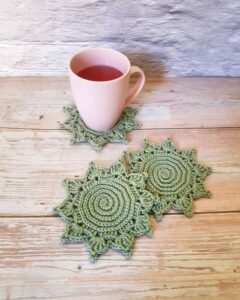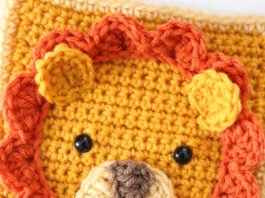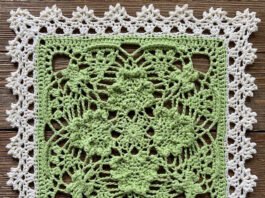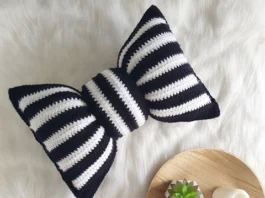Crochet patterns are a beloved craft for creating both functional and decorative items, and crochet coasters are a perfect small project that allows for creativity.
In this article, we’ll walk you through creating a stunning crochet coaster pattern with simple steps, ideal for beginners and experienced crocheters alike.
We’ll cover what materials you need, essential stitches, and a step-by-step guide to making your crochet coaster pattern come to life.

What You’ll Need to Start Your Crochet Coaster Pattern
To create a beautiful crochet coaster, you’ll need some basic crochet materials. First, gather your yarn; cotton yarn is recommended as it’s absorbent and durable, making it perfect for coasters. You’ll also need a crochet hook, usually between 4.0 mm and 5.0 mm for this project, though you can choose based on your yarn’s thickness and your desired stitch tightness.
In addition to yarn and a hook, have a yarn needle on hand for weaving in ends and a pair of scissors for cutting your yarn. A stitch marker can also be helpful to mark rounds, particularly for beginners. These basic tools will set you up for a successful project, allowing you to create a neat, even crochet coaster pattern.
Choosing the right color palette can enhance the look of your crochet coaster. Consider using solid colors for a minimalist look or blending multiple shades for a vibrant, decorative touch. Coasters are small, so this project is ideal for using leftover yarn from other crochet patterns, adding a sustainable element to your crafting.
Basic Crochet Stitches for a Coaster Pattern
To make a crochet coaster, you’ll need to know a few essential stitches. The chain stitch (ch) is one of the first stitches in almost every crochet project and serves as the foundation. Mastering this stitch will make it easier to start any crochet coaster pattern and ensure even, consistent edges.
Another essential stitch is the single crochet (sc), which is simple yet versatile. This stitch gives your crochet coaster pattern a dense texture, perfect for protecting surfaces from heat and moisture. When working with a single crochet stitch in rounds, it’s easy to control the size of the coaster by adjusting the number of stitches in each round.
The double crochet (dc) stitch is another option, especially if you want a more open, airy design. Double crochet stitches can add height and are useful for experimenting with different textures and patterns in your coaster. Learning these three basic stitches – chain, single crochet, and double crochet – will give you a strong foundation to create various crochet patterns, including coasters.
Step-by-Step Guide to Your Crochet Coaster Pattern
Follow this simple step-by-step guide to create your crochet coaster pattern. We’ll start with a foundation chain, build up with rounds, and finish with a clean edge. This pattern uses single and double crochet stitches to create a textured, circular coaster.
Step 1: Begin with a magic ring and make 6 single crochets into the ring. Tighten the ring by pulling the yarn end. This forms the center of your coaster and helps keep the shape tight and round, ideal for a functional, attractive base.
Step 2: For the second round, make 2 single crochets in each stitch around, giving you 12 stitches in total. This technique, known as increasing, is essential in circular crochet patterns and ensures that your coaster lays flat rather than curling up.
Step 3: Continue to increase in each round by adding one more single crochet between each increase. For instance, in the third round, make 1 single crochet in the first stitch, then 2 single crochets in the next, and repeat around. By the end of this round, you should have 18 stitches. This gradual increase forms a larger circle with each row, perfect for creating the desired size of your coaster.
Tips for Customizing Your Crochet Coaster Pattern
One of the joys of crochet is customization. You can easily adjust this crochet coaster pattern to make it your own by changing colors, stitches, or even the type of yarn. For instance, using a thicker yarn and larger hook will yield a larger, chunkier coaster, while fine yarn and a smaller hook create a delicate, compact design.
Experimenting with colors can make your crochet coasters unique. Try adding stripes by switching yarn colors every few rounds or creating a gradient effect with variegated yarn. These color variations make each coaster look custom-made, which can be a beautiful touch for gifts or home decor.
You can also play with stitch patterns. Adding a round of double crochet in the middle of your single crochet rounds, for instance, can create a subtle textural contrast. Combining stitches allows for an endless array of crochet patterns and opens up even more design possibilities, making your coaster pattern as personalized and unique as you wish.
Finishing Touches: Edging Your Crochet Coaster Pattern
To give your crochet coaster a polished look, consider adding an edge in a contrasting stitch or color. A popular choice is a simple slip stitch around the outer edge of the coaster, which creates a clean, defined border. This stitch is easy to do and helps keep the coaster’s shape.
For a more decorative touch, you might try a scalloped edge. This involves working multiple stitches (such as double crochets) in one stitch space to create a rounded, shell-like pattern around the edge. Scalloped edging can give your crochet coaster a delicate, handmade appearance that adds elegance to your project.
Weaving in any loose yarn ends is the final step. Use a yarn needle to tuck in the ends along the coaster’s stitches, ensuring they’re secure and won’t come loose over time. Properly finishing your crochet coaster pattern with these steps results in a beautiful, durable piece ready for use or gifting.
Caring for Your Crochet Coaster
Once completed, your crochet coaster will be functional and durable with the right care. Since coasters are often exposed to moisture, it’s essential to wash them occasionally. Hand washing with mild detergent helps maintain the yarn’s color and texture, especially if you’ve used cotton.
If you choose machine washing, place the coasters in a protective laundry bag and use a gentle cycle. This method can prevent the yarn from fraying and the stitches from loosening. Air-dry your coasters flat to keep them in shape, as heat from a dryer can damage some types of yarn fibers.
Proper storage can also keep your crochet coasters in good condition. Store them flat or stacked to avoid creasing or misshaping. With a bit of care, your crochet coasters will stay beautiful and functional for a long time, ready to protect surfaces and add charm to any room.
This guide should help you create a lovely set of crochet coasters, from start to finish!




